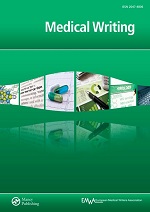
Volume 23, Issue 2 - Regulatory Writing Basics
The needs assessment in continuing medical education
Author: Nicola M. A. Parry
Abstract
The needs assessment component of a continuing medical education grant proposal document describes why a specific programme should be developed. Medical writers frequently play a central role in producing the needs assessment as an important first step in the development of an educational activity. By focusing on very specific practice gaps, and highlighting how the programme would help close those gaps, the medical writer plays a critical role in helping accredited sponsors document educational needs, and subsequently obtain funding for the activity.
 Download the full article
Download the full article
References
- Marinopoulos SS, Dorman T, Ratanawongsa N, Wilson LM, Ashar BH, Magaziner JL, et al. Effectiveness of continuing medical education. Evid Rep Technol Assess 2007;149:1–69.
- Ghosh AK. Organizing an effective continuous medical education session. J Assoc Physicians India 2008;56:533–38.
- Norman GR, Shannon SI, Marrin ML. The need for needs assessment in continuing medical education. BMJ 2004;328:999–1001.
- Shannon S. Educational objectives for CME programmes. Lancet 2003;361:1308.
- ACCME.org. Chicago (IL): Accreditation Council for Continuing Medical Education. c2012 [cited 2014 Feb 1]. Available from: http://www.accme.org/
- EACCME.eu. Brussels (Belgium): European Accreditation Council for Continuing Medical Education. c2010 [cited 2014 Feb 1]. Available from: http://www.eaccme.eu/
- Shannon S. Needs assessment for CME. Lancet 2003;361:974.
- National Association for Continuing Education: Guidelines for needs assessments. c2014 [cited 2014 Feb 1]. Available from: http://naceonline.com/needs_assessment.php
- Association of American Medical Colleges. Washington (DC): The scientific basis of influence and reciprocity: A symposium. c2007 [cited 2014 Feb 1]. Available from: https://members.aamc.org/eweb/upload/The%20Scientific%20Basis%20of%20Influence.pdf
- Avorn J, Choudhry NK. Controversies in cardiovascular medicine. Funding for medical education: maintaining a healthy separation from industry. Circulation 2010;121:2228–34.
- Indiana University. Division of Continuing Medical Education, School of Medicine. Indianapolis (IN): How Tos: Writing measureable educational objectives. c2007 [cited 2014]. Available from: http://cme.medicine.iu.edu/event-development/
- Drexel University College of Medicine. Philadelphia (PA): CME Tools: Action verbs for developing objectives. c2014 [cited 2014 Feb 1]. Available from: https://www.drexelmed.edu/Home/OtherPrograms/ContinuingMedicalEducation/CMEToolkit.aspx
Search
Articles
Links
Editoral Board
Editor-in-Chief
Co-Editors
Managing Editor
Victoria White
Associate Editors
Section Editors
AI/Automation
Biotechnology
Digital Communication
EMWA News
Gained in Translation
Getting Your Foot in the Door
Good Writing Practice
In the Bookstores
Publications
Medical Communications/Writing for Patients
Medical Devices
My First Medical Writing
News from the EMA
Freelancing
Pharmacovigilance
Regulatory Matters
Regulatory Public Disclosure
Teaching Medical Writing
Louisa Ludwig-Begall / Sarah Kabani
The Crofter: Sustainable Communications
Veterinary Writing
Editors Emeritus
Layout Designer
Chris Monk
 Visit the EMWA website
Visit the EMWA website